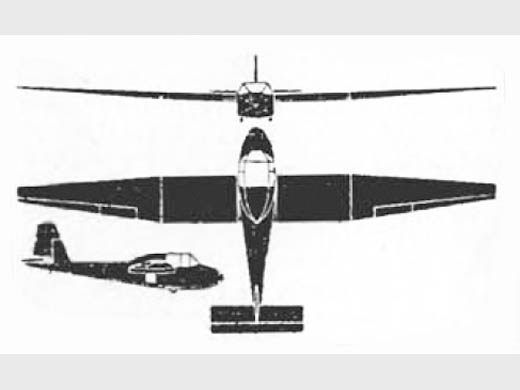
N2-53
| DONNÉES GÉNÉRALES |
| Année du premier vol (ou de design, si seul projet) |
1956 |
| Pays | URSS |
| Designer(s) | TRUNCHENKOV, N. S. & LOSHAKOV, A. A. & KORCHAGIN, V. A. |
| Premier constructeur | Projet non abouti |
| Type d'appareil | Planeur |
| Fonction | Entraînement |
| SPÉCIFICATIONS TECHNIQUES |
| Envergure | -- |
| Longueur | -- |
| Hauteur | -- |
| Allongement | -- |
| Surface alaire | -- |
| Profil aile | -- |
| Masse à vide | -- |
| Masse maxi | -- |
| Charge alaire | -- |
| Vitesse mini | -- |
| Vitesse maxi | -- |
| Finesse maxi | |
| Taux de chute mini | -- |
| Nb sièges | 2 |
| Structure | -- |
AUTRES INFORMATIONS
| Constructeur(s) |
| ||||||
| Infos techniques | Biplace cote à cote. The wings have parallel-ch1lrd centre section and tapered outer sections. They are rather reminiscent of the Yakovlev cargo glider, as is the whole layout of the N2-53. The fin has neady all the taper on the leading edge, and the tailplane, which is of rectangular form, is mounted low so that the elevator, which projects behind the fuselage, has no cut-out for the rudder. Unfortunately the tail unit is largely blanketed by the wing at high angles of attack, and the wide rear fuselage has the airflow disturbed by eddies from the wing too. The ailerons are in two sections, the outer ones being of much larger span than the inner ones, and occupy most of the outer section trailing edge. The landing gear consists of two wheels mounted at the sides of the fuselage belly, level with the wing leading edge. While Sheremetev's design is a tandem high-wing monoplane. the Novosibirsk type is a side-by-side mid-wing monoplane, so it does not seem that the Russians have any definite preference for either layout. The construction is entirely of wood. This type is fitted with novel braking flaps in the fuselage sides, but il is difficult to see why these have been adopted as their efficiency is considerably less than thal of spoilers in the wings. Probably the designers thought they were simpler. The N2-53 suffers from the defects inherent in the side-by-side layout, namely the large fuselage width and the consequent increase in drag resulting in loss of performance, and the necessity of carrying ballast when the aircraft is flown as a single-seater, thus negativing the extra performance which wQuld be gained by decrease in weight. In an attempt to alleviate the latter defect, the designers have staggered the seating by 10 cm., the starboard seat being set back by that amount. However, this results in the. restriction of longitudinal seat adjustment by 5 cm. for each seat, which is nonlery convenient. | ||||||
| Histoire résumée | Un concours de design de planeur biplace d'entraînement fut organisé en URSS en 1956, en vue de remplacer le célèbre Antonov A-2, qui après 20 ans de bons et loyaux services, ne répond plus maintenant aux standards actuels. Le concours était organisé par la DOSAAF qui avait envoyé des invitations à participer à de nombreux designers et organismes. Toutes les inscriptions ont été faites sous des pseudonymes afin que les noms des concepteurs ne soient révélés qu'après la publication des résultats. Le règlement stipulait que le projet devait conduire à une construction facile, pour une machine légère et robuste, mais ayant de bonnes qualités de vol. Le 2e prix prix de ce concours fut attribué au N2-53, dessiné N. S. Trunchenkov, A. A. Loshakov and Y. A. Korchagin de la section dee Novosibirsk branch de la DOSAAF. Les 3 designers sont très jeunes, ce qui augure bien de l'avenir. Il n'y eut pas de construction. | ||||||
| Liens personnalités | Pas de personnalité associée. |
SOURCES DOCUMENTAIRES
| Liens WEB | Pas de site référencé. |
| Livres | Pas de livre référencé. |
| Autres sources | A Russian Glider Design Competition, par R.A.G. Stuart, Sailplane and Gliding, volume 7 n° 1, février 1956 |

Team J2mcL © 2003 -
- Pages optimisées pour Mozilla Firefox

